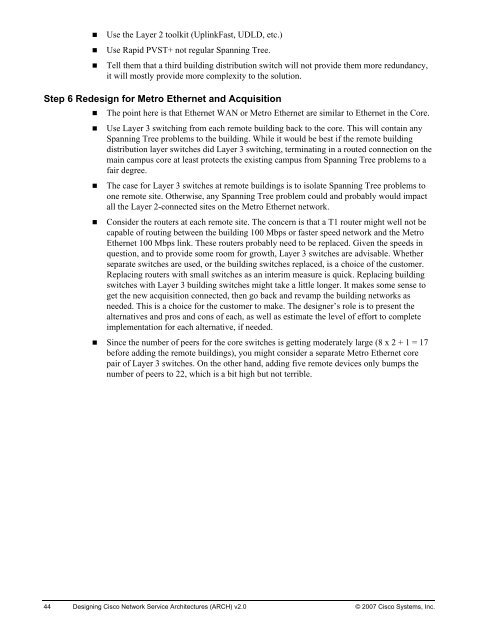Designing Cisco Network Service Architectures - Free Books
Designing Cisco Network Service Architectures - Free Books
Designing Cisco Network Service Architectures - Free Books
Create successful ePaper yourself
Turn your PDF publications into a flip-book with our unique Google optimized e-Paper software.
• Use the Layer 2 toolkit (UplinkFast, UDLD, etc.)• Use Rapid PVST+ not regular Spanning Tree.• Tell them that a third building distribution switch will not provide them more redundancy,it will mostly provide more complexity to the solution.Step 6 Redesign for Metro Ethernet and Acquisition• The point here is that Ethernet WAN or Metro Ethernet are similar to Ethernet in the Core.• Use Layer 3 switching from each remote building back to the core. This will contain anySpanning Tree problems to the building. While it would be best if the remote buildingdistribution layer switches did Layer 3 switching, terminating in a routed connection on themain campus core at least protects the existing campus from Spanning Tree problems to afair degree.• The case for Layer 3 switches at remote buildings is to isolate Spanning Tree problems toone remote site. Otherwise, any Spanning Tree problem could and probably would impactall the Layer 2-connected sites on the Metro Ethernet network.• Consider the routers at each remote site. The concern is that a T1 router might well not becapable of routing between the building 100 Mbps or faster speed network and the MetroEthernet 100 Mbps link. These routers probably need to be replaced. Given the speeds inquestion, and to provide some room for growth, Layer 3 switches are advisable. Whetherseparate switches are used, or the building switches replaced, is a choice of the customer.Replacing routers with small switches as an interim measure is quick. Replacing buildingswitches with Layer 3 building switches might take a little longer. It makes some sense toget the new acquisition connected, then go back and revamp the building networks asneeded. This is a choice for the customer to make. The designer’s role is to present thealternatives and pros and cons of each, as well as estimate the level of effort to completeimplementation for each alternative, if needed.• Since the number of peers for the core switches is getting moderately large (8 x 2 + 1 = 17before adding the remote buildings), you might consider a separate Metro Ethernet corepair of Layer 3 switches. On the other hand, adding five remote devices only bumps thenumber of peers to 22, which is a bit high but not terrible.44 <strong>Designing</strong> <strong>Cisco</strong> <strong>Network</strong> <strong>Service</strong> <strong>Architectures</strong> (ARCH) v2.0 © 2007 <strong>Cisco</strong> Systems, Inc.
















